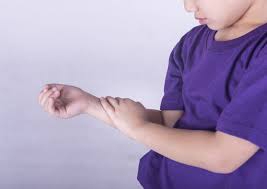
Juvenile idiopathic arthritis (JIA), previously known as juvenile rheumatoid arthritis, is the most common type of arthritis in children. Arthritis is a long-term condition characterized by stiffness, swelling, and pain in the joints.
An estimated 300,000 children in the United States have a form of arthritis. Some children have arthritis for just a few months, while others have arthritis for several years. In rare cases, the condition can last a lifetime.
The exact cause of JIA isn’t known. However, researchers believe it’s primarily an autoimmune disease. In people with autoimmune diseases, the immune system can’t differentiate between the healthy cells in the body and harmful substances, such as viruses and bacteria. This causes the immune system to mistakenly attack harmless cells as though they are dangerous invaders.
In children with JIA, the immune system releases substances, mainly cytokines, that damage healthy tissues in the body. This causes inflammation and pain in the joints.
Most cases of JIA are mild, but severe cases may result in complications, such as joint damage and chronic pain. Knowing the symptoms of JIA is important for getting treatment before the condition progresses.
Treatment usually consists of decreasing inflammation, controlling pain, improving function, and preventing joint damage. This can help ensure your child maintains an active, productive lifestyle.
What are the symptoms of juvenile idiopathic arthritis?
The most common symptoms of JIA include:
- joint pain
- stiffness
- reduced range of motion
- warm and swollen joints
- limping
- redness in the affected area
- swollen lymph nodes
- recurrent fevers
JIA may affect one joint or multiple joints. In some cases, the condition can affect the entire body, causing a rash, fever, and swollen lymph nodes. This subtype is called systemic JIA (SJIA), and occurs in about 10 to 20 percent of children with JIA. Researchers think SJIA is an autoinflammatory disease, which is different from an autoimmune disease.
What are the types of juvenile idiopathic arthritis?
There are six types of JIA:
- systemic JIA, which affects the internal organs and one or more joints
- oligoarticular JIA, which affects four or fewer joints
- polyarticular JIA, which affects five or more joints (The protein known as rheumatoid factor may or may not be present.)
- juvenile psoriatic arthritis, which affects the joints and occurs with psoriasis
- enthesitis-related JIA, which affects where bone meets the tendons and ligaments (The genetic marker HLA-B27 is often present.)
- undifferentiated arthritis, where symptoms may span two or more subtypes or not fit any of the other subtypes
The more joints that are affected, usually the more severe the disease.
How is juvenile idiopathic arthritis treated?
Various treatments can effectively manage and minimize the effects of JIA. Doctors usually recommend a combination of treatments to relieve pain and swelling and to maintain movement and strength.
Medical treatment
Nonsteroidal anti-inflammatory drugs (NSAIDs), such as ibuprofen (Advil) and naproxen (Aleve), are often used to reduce inflammation and swelling.
Stronger medications may also be prescribed if over-the-counter (OTC) medications aren’t effective. Aspirin might be recommended, but this is rare because the medication may cause adverse side effects in children. Never give your child aspirin without a doctor’s consent.
Other prescription medications known as biological agents might also be used to help decrease inflammation and joint damage. These include:
- abatacept (Orencia)
- rituximab (Rituxan)
- anakinra (Kineret)
- tocilizumab (Actemra)
- etanercept (Enbril)
Such medications can ease symptoms by suppressing the immune system. However, they may take several months to reach maximal benefit.
In some cases, a drug called methotrexate is used to suppress joint inflammation in children with JIA.
In severe cases of JIA, surgery may be used to replace the joints altogether. Fluids might also be extracted from the tissues to reduce inflammation, and a steroid medication may be injected into the joint.
What are the potential complications of juvenile idiopathic arthritis?
Untreated JIA can lead to further complications. These include:
- anemia
- long-term recurring pain
- joint destruction
- stunted growth
- uneven limbs
- changes in vision
- pericarditis, or swelling around the heart
Lifestyle remedies
Exercising and maintaining a healthful diet are important for everyone, but they’re especially beneficial for children who have JIA. Having your child make the following lifestyle adjustments can help them cope with their symptoms more easily and reduce the risk of complications:
Eating well - Weight changes are common in children with JIA. Medications may increase or decrease their appetite, causing rapid weight gain or weight loss. In such cases, a healthful diet containing the right amount of calories can help your child maintain an appropriate body weight.
Speak with a doctor about a meal plan if your child is gaining or losing too much weight as a result of JIA.
Exercising regularly - Exercising at least three times per week can strengthen muscles and improve joint flexibility, making it easier to cope with JIA in the long run. Low-impact exercises, such as swimming and walking, are usually best. However, it’s a good idea to speak with a doctor before your child begins a new workout routine.
Physical therapy - A physical therapist can teach your child the importance of sticking with an exercise routine and can even recommend exercises suited to their specific condition. The therapist may suggest certain exercises that can help build strength and restore flexibility in stiff, sore joints.
Source: https://www.healthline.com/health/juvenile-rheumatoid-arthritis#symptoms





